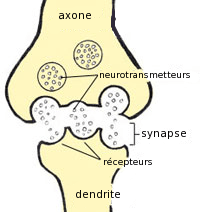Neurotransmitter facts for kids
Neurotransmitters are like tiny chemical messengers in your body. They help your brain and nervous system send important signals. Imagine your brain as a huge network of tiny wires called neurons. These wires need to talk to each other.
When an electrical signal reaches the end of one neuron, it can't jump directly to the next one. There's a tiny gap called a synapse. This is where neurotransmitters come in! The electrical signal changes into a chemical signal using neurotransmitters. These chemicals then cross the gap.
Once they reach the next neuron, they are absorbed. The neuron then changes the chemical signal back into an electrical signal. This new electrical signal, called an action potential, then travels along the next neuron. This process allows messages to zoom all over your body!
Many neurotransmitters are made from amino acids. These are building blocks from the food you eat. Neurotransmitters are super important for everything you do every day. Scientists have found over 100 different types of these chemical messengers. Each one has a special job.
For example, dopamine helps with feelings of reward and pleasure. Noradrenaline helps your body get ready for "fight or flight" situations. Neurotransmitters also control how strong a message needs to be to get sent. An electrical signal must reach a certain strength, called a threshold, before neurotransmitters are released.
The most common neurotransmitter in your brain is glutamate. It helps excite or activate over 90% of the connections in your brain. Another common one is GABA. This one does the opposite; it helps calm or inhibit over 90% of the other connections.
Neurotransmitters are carried inside neurons in tiny "sacks" called vesicles. When these sacks touch the neuron's outer layer, they open up. This releases the neurotransmitters into the tiny gap between neurons, ready to send their message!
How Neurotransmitters Were Discovered
For a long time, scientists thought that all brain signals were electrical. But in the early 1900s, a scientist named Santiago Ramón y Cajal found a tiny gap between neurons. This gap, called the synaptic cleft, suggested that chemicals might be involved in sending messages.
Then, in 1921, a German scientist named Otto Loewi proved it! He did experiments with frog hearts. He showed that neurons could communicate by releasing chemicals. He even discovered the first known neurotransmitter, called acetylcholine (ACh).
Some neurons can also talk using direct electrical signals. They use special connections called gap junctions. These allow tiny charged particles, called ions, to pass directly from one cell to another. But most communication in your brain happens with chemical messengers!
Images for kids
See also
 In Spanish: Neurotransmisor para niños
In Spanish: Neurotransmisor para niños





